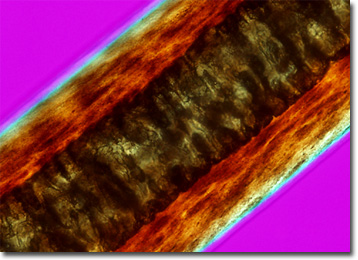Polarized Light Microscopy Digital Image Gallery
Otter Hair
Often a favorite sight at zoos because of their playful nature, even adult otters seem to enjoy sliding down banks into water and sociably playing games of “follow the leader.” Highly trainable when efforts begin early, these members of the weasel family Mustelidae can also be taught a number of entertaining tricks by humans.

Inhabitants of all the continents of the world with the exception of Australia, four different genera of otters have been identified, the species of which vary somewhat. Some, for instance, are freshwater animals, while others inhabit the sea, and the color of their coats and the size of their bodies may differ considerably. All otters, however, have webbed feet and are excellent swimmers, which can journey for about a quarter of a mile underwater before they must surface to breathe. They are also capable of traveling surprisingly fast by land, though they prefer to remain in the water, where they commonly feed up fish, frogs, and other small aquatic creatures.
One of the most valuable commodities in the fur industry, the fur of the otter consists of two different layers. The outer layer is composed of tightly knit guard hairs that form a watertight barrier between the animal and its environment. The underfur of the otter is even denser than the guard hairs and, in fact, at as many as one million hairs per square inch, is believed to be the thickest fur of any mammal on the planet. When this underfur is in good condition and well groomed, it is capable of trapping an insulating layer of air, keeping the otter’s skin dry and protected from the cold of surrounding water.
